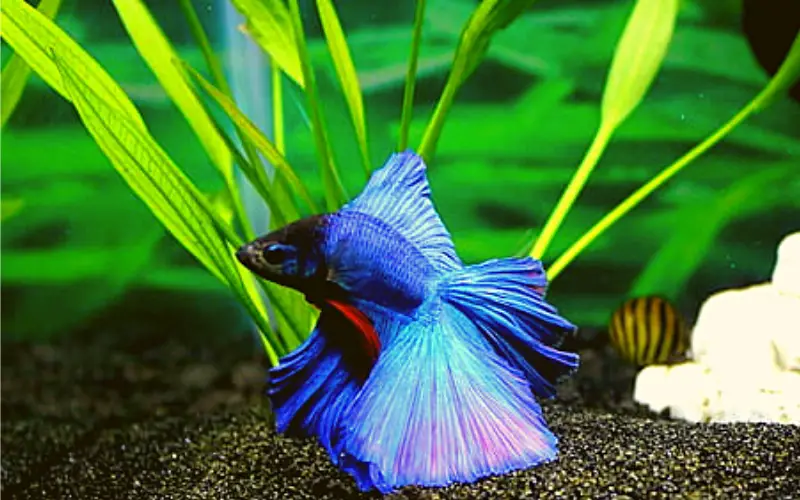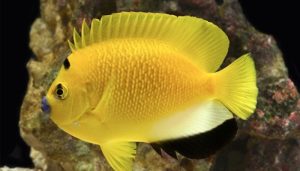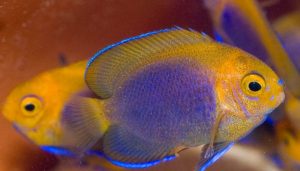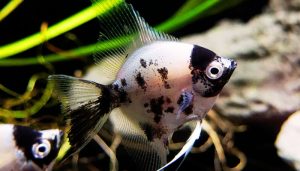Popeye Betta disease is a common ailment caused by various factors such as bacterial infections, poor water conditions, and physical injuries. It is characterized by the swelling of the betta fish’s eyes, giving it the appearance of Popeye, the sailor man.
This condition can be distressing for betta fish owners, but effective treatments are available to help alleviate the symptoms and improve the overall health of the fish.
In this article, we will explore some of the most effective Popeye betta treatments betta fish owners can use to address this condition and relieve their beloved pets. From medication to water testing and proper tank maintenance, several approaches can be taken to combat Popeye’s disease and prevent its recurrence.
By understanding the causes and symptoms of Popeye disease and implementing the appropriate treatments, betta fish owners can help their fish recover and thrive once again.
Table of Contents
ToggleCauses of Popeye Betta Fish Disease
Popeye in betta fish, also known as exophthalmia, can be caused by various factors. One common cause of Popeye is poor water quality, including high ammonia and nitrates.
These can lead to bacterial infections, which can, in turn, cause Popeye. Injuries to the eye or head from fighting with other fish or hitting sharp objects in the aquarium can also lead to Popeye.

Another potential cause is a poor diet lacking essential nutrients, weakening the fish’s immune system and making it more susceptible to infections.
Additionally, stress from overcrowded or dirty tank conditions, as well as fluctuations in aquarium water temperature, can also contribute to the development of Popeye.
Betta fish owners need to maintain a clean and stable environment for their fish to prevent the onset of Popeye disease. Regular water changes, proper nutrition, and providing enough space and hiding spots for the fish can all help prevent and treat the popeye condition.
Note: Betta fish may develop unilateral Popeye (affecting one eye) or bilateral Popeye (affecting both eyes). It is essential to identify the specific type for accurate diagnosis and treatment.
What Are the Symptoms of Popeye in Bettas?
Popeye in bettas is characterized by swelling or protrusion of one or both eyes. The affected eye may appear larger than usual and can even change color.
In addition to the physical changes in the vision, bettas with Popeye may also display other symptoms such as lethargy, loss of appetite, and changes in behavior.
Some bettas may also exhibit signs of discomfort or pain, such as rubbing their eyes against objects in the tank.
Betta owners must monitor their fish closely for signs of Popeye and seek veterinary care promptly if they suspect their fish is affected.
Popeye in Bettas can be caused by bacterial infections, parasites, or physical trauma, and treating the underlying cause is crucial for successfully resolving the condition.
With proper care and treatment, bettas with Popeye can often fully recover and return to their active and healthy selves.
Additional popeye symptoms: In severe cases, you may also observe:
- Cloudy vision
- Retinal loss
- Changes in eye pigment
- Bloodshot eyes
- Deformed or bulging eyelids
Severity: The severity of Popeye can vary depending on the underlying cause and progression of the condition. Early detection and treatment are crucial to prevent complications like blindness, bettas eyes bulging, or even death.
Remember:
- If you notice these symptoms in your Betta, acting quickly and isolating the fish in a clean quarantine tank is essential.
- Consult a veterinarian or experienced aquarist for proper diagnosis and treatment.
- Maintaining good water quality and avoiding overcrowding in the tank can help prevent and treat Popeye in the first place.
With prompt action and proper care, your Betta can recover from Popeye and get back to swimming happily.
How To Treat Popeye In Betta Fish?
To treat betta fish popeye, it is crucial first to isolate the affected fish in a separate quarantine tank to prevent the spread of infection to other fish in the tank. Then, the water in the tank should be kept clean and well-maintained, with frequent water changes to minimize the bacteria and reduce the risk of further infection.
Adding aquarium salt to the tank water can also help to reduce the swelling and aid in the fish’s recovery. Antibiotic medications may sometimes be necessary to treat the underlying bacterial infection.
It is essential to consult with a veterinarian or a knowledgeable fish specialist to determine the best course of bettas Popeye treatment and prevention, as the condition can indicate other underlying health issues that may need to be addressed.
Here’s how to treat betta fish with Popeye (Tips)
1. Isolate the affected fish:
- Move your Betta to a separate quarantine tank with clean, conditioned water. This prevents the Popeye from spreading to other fish.
2. Improve water quality:
- Perform a 50% water change in both the primary and quarantine tanks.
- Test the water for ammonia, nitrite, and nitrate levels. Ammonia and nitrite should be undetectable, and nitrate should be below 20 ppm.
- If water quality is poor, perform additional water changes and consider using a water conditioner to neutralize harmful chemicals.
3. Determine the cause:
- Injury: If the Popeye is likely due to injury, Epsom salt baths can help reduce inflammation. Add 1 tablespoon of Epsom salt per gallon of water to the quarantine tank and let your Betta bathe for 10-15 minutes. Repeat daily for 3-5 days.
- Infection: Antibiotics are necessary if the Popeye is likely due to illness. Kanamycin and Maracyn are effective medications for treating PopeyePopeye in bettas. Follow the dosage instructions on the pill carefully.
4. General supportive care:
- Maintain the water temperature in the quarantine tank at 78-82°F.
- Offer small, high-quality foods that your Betta can quickly eat.
- Reduce stress by providing hiding places and keeping the tank lighting subdued.
5. Monitor your betta:
- Keep an eye on your Betta’s Popeye for any improvement or worsening.
- If the Popeye does not improve within a few days or your Betta’s condition worsens, consult a veterinarian or fish specialist for further advice.
Here are some additional tips for preventing betta fish Popeye:
- Maintain good water quality by performing regular water changes and using a water conditioner.
- Provide your Betta with a spacious and well-decorated tank to reduce stress.
- Feed your Betta a healthy diet of high-quality pellets or flakes.
- Avoid overcrowding your tank.
- Quarantine new fish before adding them to your main tank.
Following these tips can help keep your betta fish healthy and prevent Popeye from occurring.
Remember, early diagnosis and treatment are essential for a successful outcome. If you notice Popeye in your betta fish, act quickly to isolate the fish and improve water quality. With proper care, your Betta should make a full recovery.
Can You Prevent Popeye in bettas? (Avoid Popeye)
While Betta Popeye’s disease is not always preventable, there are steps you can take to minimize the risk. Keeping your Betta in a clean and properly maintained tank is essential.
Regular water changes and a proper filtration system can help prevent bacterial infections that may lead to Popeye. Additionally, feeding your Betta a balanced diet and avoiding overfeeding can prevent the condition.
Monitoring your Betta’s behavior and appearance regularly is crucial so you can catch any signs of illness early on. If you notice any changes in your Betta’s eye size or behavior, it’s essential to seek advice from an experienced fish veterinarian.
While not all cases of Popeye can be prevented, taking these precautions can help decrease the likelihood of your Betta developing the condition.
Cures for Bettas Popeye Infections
While bettas popeye isn’t contagious to other fish, it can indicate underlying issues like dirty water or stress. Here are some approaches to cure Popeye in your betta fish:
Immediate Actions:
- Isolate the affected fish: Move your Betta to a quarantine fish tank with clean, dechlorinated water. This prevents the Popeye from spreading to other fish and allows you to treat the affected fish effectively.
- Improve water quality: Perform a 50% water change in the main and quarantine tanks. Maintain good water quality by regularly performing water changes (25% weekly) and ensuring proper filtration.
Treatment Options:
- Antibiotics: If Popeye is caused by bacteria, antibiotics like kanamycin, erythromycin, or tetracycline can be effective. These can be found in commercial medications like Maracyn Two or Kanaplex. Follow the dosage instructions carefully and complete the entire course of treatment, even if the symptoms improve early.
- Anti-fungals: Antifungal medications like Maracyn can be used if a fungal infection is suspected.
- Epsom salt baths: Epsom salt can help reduce inflammation and swelling. Dissolve one tablespoon of Epsom salt per gallon of water in a separate container. Give your Betta 10-15 minute baths in this solution daily for a few days.
Cures for Betta Popeye caused by injury
Curing Popeye in bettas caused by an injury requires different approaches than treating Popeye caused by bacterial or fungal infections. Here’s how to handle an injured eye:
Immediate Care:
- Isolating the Betta: Move your Betta to a separate quarantine tank with clean water to prevent further injury or the spread of any potential secondary infections.
- Water Quality: Ensure pristine water conditions in the main and quarantine tanks. Perform frequent water changes (25-50%) to ensure good water quality and remove pollutants.
- Stress Reduction: Minimize stress during treatment. Keep the quarantine tank quiet and dimly lit. Avoid handling the Betta unnecessarily.
Treatment Options:
Epsom Salt Baths:
- Preparation: Mix 1 teaspoon of Epsom salt (magnesium sulfate) with 1 gallon of clean, temperature-adjusted water. Do not use table salt or Epsom salt with additives.
- Bath: Place the Betta in the Epsom salt bath for 10-15 minutes. Observe closely for any signs of stress and remove the Betta immediately.
- Frequency: Repeat Epsom salt baths once or twice daily for 3-5 days.
Aquarium Salt:
- Dosage: Add 1 teaspoon of aquarium salt per gallon of water in the quarantine tank. Do not use table salt as it contains harmful additives.
- Duration: Maintain the salt concentration for 3-5 days, then gradually reduce by performing small water changes without salt. Monitor your Betta closely during salt treatment.
Additional Care:
- Diet: Offer your Betta a nutritious, easily digestible diet to support healing.
- Tank Environment: Remove any sharp objects or decorations from the main tank that could have caused the injury.
- Observe your Betta closely for any improvement or worsening of the Popeye. Consult a veterinarian or experienced aquarist if the eye doesn’t show signs of recovery within 5-7 days or if the fish exhibits other concerning symptoms like lethargy, loss of appetite, or fin clamping.
Important Notes:
- Antibiotics are not usually necessary for Popeye caused by injury. Only use antibiotics if a secondary bacterial infection develops, which should be diagnosed by a veterinarian.
- Medications: Avoid using over-the-counter medicines without consulting a veterinarian or experienced aquarist. Some medications can harm your Betta.
- Patience: Healing from an injury takes time. Be patient and consistent with your treatment plan.
Early diagnosis and proper care are crucial for a successful recovery from a Popeye injury. If you have any concerns or doubts, don’t hesitate to seek professional advice from a veterinarian or aquarist specializing in fish health.
Commonly Asked Questions about How to Treat Betta Popeye Disease (FAQs)
Why is my betta fish’s eye bulging?
A bulging eye in a betta can be caused by Popeye, often due to infection, injury, or poor water quality. Prompt action is crucial, as untreated Popeye can lead to blindness or death. Consult a vet or experienced fishkeeper for diagnosis and treatment.
Can you give a betta fish an Epsom salt bath for Popeye?
Epsom salt baths can be helpful for betta popeye in mild cases but use caution. Use 1 tablespoon per gallon in a clean, separate container for 10-15 minutes.
What is the best treatment for fish Popeye?
What is the best medication for Popeye? The best treatment for fish Popeye is to administer antibiotics in a separate hospital tank, maintain clean water conditions, and address any underlying causes of the condition.
What fish antibiotic treats Popeye?
While several antibiotics can help, Erythromycin (API E.M. Erythromycin) is a common, practical choice for treating Popeye caused by bacterial infections in various fish. Remember, consult a vet for severe cases.
How long does it take for Betta fish to recover from Popeye?
Betta Popeye’s recovery time varies, with visible improvement within 3-5 days and full healing in 1-3 weeks (sometimes longer). Severe cases or complications may require longer recovery or vet care.
How do you treat a betta fish’s eyes that are bulging?
To treat a betta fish with bulging eyes, ensure clean water conditions. If the condition persists, consult a veterinarian for appropriate medication, as it could be a sign of infection or other underlying health issues.
What causes bulging eyes in fish?
Bulging eyes in fish can be caused by various factors, including bacterial or fungal infections, poor water quality, trauma or injury, genetic predisposition, or underlying health issues. Consult a veterinarian for a proper diagnosis and treatment.
Conclusion
In conclusion, betta fish can develop Popeye for various reasons, including poor water conditions, bacterial infections, and physical injuries. Fish owners need to maintain the water quality in their aquariums regularly and ensure that their bettas are not facing any aggressive behavior from tank mates. Additionally, a balanced diet and avoiding overfeeding can help prevent Popeye in betta fish.
If a betta does develop Popeye, it is crucial to act quickly and seek proper treatment, which may include administering antibiotics, improving water conditions, and isolating the affected fish. By carefully monitoring and addressing the potential risk factors for Popeye, betta fish owners can help ensure their beloved aquatic pets’ overall health and well-being. It is important to remember that prevention and proper care are vital in maintaining the health and happiness of betta fish in captivity.
You might also like
- Betta Velvet Disease 101: Symptoms, Treatment & Prevention
- Betta Fish Water Parameters: 5 Easy Tips for Vibrant Bettas!
- How to Help a Dying Betta Fish? (7 Reasons Your Bettas Die)
- Better Betta Fish Rescue: Giving Hope to Neglected Fish!
- Maintaining The Ideal Ph for Betta Fish Aquarium (Solved!)
- Betta Columnaris: Symptoms, Treatment, and Prevention!




